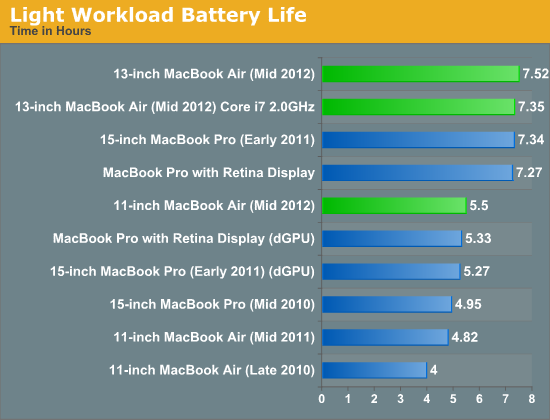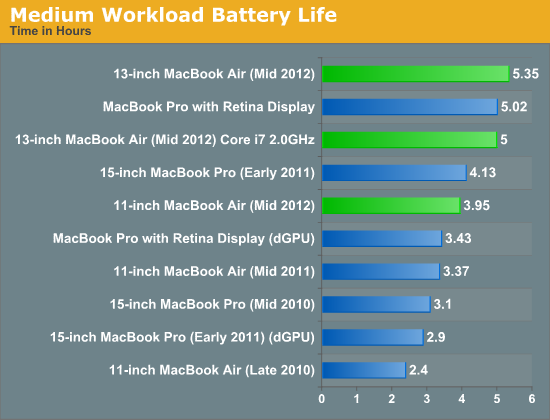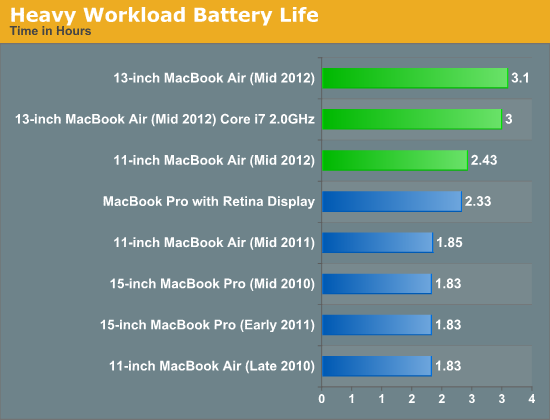The 2012 MacBook Air (11 & 13-inch) Review
by Anand Lal Shimpi on July 16, 2012 12:53 PM EST- Posted in
- Apple
- Mac
- MacBook Air
- Laptops
- Notebooks
Battery Life
The MacBook Air sees no increase in battery capacity over the previous generation, as a result any improvement in battery life boils down to what we get from Ivy Bridge. I'm stuck rebuilding the battery life results database from scratch now that I've built a new suite of tests for OS X. I've run all three generations of 11-inch MacBook Air through the new suite but I don't have numbers for the older 13-inch MBAs unfortunately. As I mentioned in the rMBP review, the new suite is designed to give accurate data points at three usage models: one light, one medium and one heavy. The combination of all three should give you an idea of the behavior of these systems on battery.
Across the board battery life of the 13-inch MacBook Air is actually quite similar to the Retina MacBook Pro, just from a much smaller battery and without the variability introduced by the rMBP's discrete GPU. If anything the lack of a discrete GPU makes using the MacBook Air much simpler from a battery life perspective. As much as I love Cody Krieger's gfxCardStatus application, it's nice not having to keep an eye on it to see if something silly has triggered the dGPU.

Under light usage the new 13-inch MacBook Air is easily able to meet Apple's claim of 7 hours of battery life. The 11-inch model does the same to its 5 hours rating, beating it by the same 30 minute margin as the 13.

The medium workload thins the herd a bit, with the 13-inch Air still coming out on top but at 5.35 hours. The 11-inch Air drops below 4 hours, which is an improvement over the previous two generations of 11-inch Airs. Once again we see an example of Ivy Bridge doing better than Sandy Bridge when it comes to mobile power usage.

Under heavy load is really where we see Intel's 22nm process deliver the gold. Here both of the 2012 MacBook Air models do very well. With the 13-inch MBA significantly outpacing even the rMBP with its 95Wh battery, while doing the exact same amount of work.
The 13-inch MacBook Air continues to be Apple's best notebook for those who care about battery life. The 11 offers portability but you do take a significant hit in battery life.










190 Comments
View All Comments
Osamede - Tuesday, July 17, 2012 - link
This Y5 was highly portable. If you never used one you have no idea. It was wedge shaped. And the shape allowed for durablity. It was military grade and rated to survive a drop of several feet. And yes STILL only 3.5 lbs, In 2004.Besides its now 2012, give us a call when Apple manages to bring to market a 14" laptop with optical drive at 3.5 lbs.. Only God knows the kind of hype we would have heard it it was Apple doing what Panasonic managed damn near a decade ag.
There was also the even smaller Panasonic W series and before that Sharp had some really good products with the Actius series at really good prices. And now thats going back to probably 1998 or even earlier
Of course Apple fanboys imagine that the world began when Apple launched the MacBook Air. Pschew.....
KPOM - Tuesday, July 17, 2012 - link
Apple isn't going to make any more notebooks with optical drives. Once the classic MacBook Pro is phased out, optical drives are history at Apple. If you notice, most Ultrabooks lack them, as well.A wedge design topping out at 1.9" thick is still pretty bulky. Obviously it was designed for a niche audience, since they aren't selling them anymore. From the specs in 2007 it had a Core Duo 1.66GHz, topped out at 1.5GB RAM, and was very expensive. The keyboard also looks cramped.
http://www.trustedreviews.com/Panasonic-ToughBook-...
I'm not disputing that there were ultraportables before the MacBook Air. Heck, I've even pointed to the PowerBook Duo. I've always been a fan of ultraportables and though they were a long-neglected category. Apple itself didn't have one for 2 years after the 12" Powerbook was dropped.
Most ultraportables were slow sellers that were quietly abandoned. To its credit, Apple stuck with the MacBook Air. A lot of Apple fans were even calling for Apple to drop the MacBook Air as late as September 2010. However, they stuck with it and continued to perfect the design. It's indisputable that the release of the $999 11.6" MacBook Air in October 2010 launched the concept of a mainstream ultraportable.
Osamede - Friday, July 20, 2012 - link
Nice try with the red herring about optical drive.The Panasonic was 3.5 lbs with Optical dive. Take that weight out and you have a 14" laptop with 1400 x 1050 at 3.2 lbs.....in 2006.
And yet according to you we are all supposed to roll over in supplication because in 2012 Apple is selling 13" laptops that weight 3lbs. Spare me the hype. Even The 2010 Sony Z is already a superior laptop compared to even todays "latest" MacBook Air, let alone the 7 year old Panasonic model.
Some of you swallow marketing BS and think it is fact.
KPOM - Friday, July 20, 2012 - link
Red herring? You are the one claiming that Apple should be putting in optical drives if they want to brag. My point is that optical drives are mostly passé. Intel hasn't made it part of the Ultrabook standard. Sony's Vaio Z is an impressive machine, but at more than twice the cost of the base MacBook Air it had better be.I'm not saying we need to roll over in supplication. What I am saying is that Apple transformed the ultraportable from a niche device to a mainstream device. My whole point, which your red herring about Panasonic Toughbooks and Sony Vaios ignores, is that ultraportables had been around for a decade but weren't popular devices until Apple got the formula right. Maybe Panasonic could have made a 14" laptop with 1400x1050 at 3.2lbs in 2006, but they didn't. Maybe Sony could have made a $999 Sony Vaio in 2010, but they didn't. Apple DID make a $999 MacBook Air in 2010. Apple DID make an ultraportable with a full size keyboard and super slick trackpad in 2008, and they DID make it affordable in 2010, and they DID take the drastic step of dropping hard drives and going exclusively with SSD storage in 2010.
phillyry - Tuesday, March 26, 2013 - link
You can't just say that this other laptop was lighter than it actually was because it would be lighter if it didn't have an optical drive that it did have. Confused much? That's because it doesn't make sense. Your logic is flawed. It either had the drive and the weight and bulk that go with it (as it did) or it didn't (as in your imaginary best case).phillyry - Tuesday, March 26, 2013 - link
Also, Apple is phasing out the optical drive. No red herring there.KPOM - Tuesday, July 17, 2012 - link
"Of course Apple fanboys imagine that the world began when Apple launched the MacBook Air. Pschew..... "Actually a lot of "Apple fanboys" HATED the original MacBook Air.
Read some of the comments to this article: http://www.macworld.com/article/1131583/macbookair...
As for optical drives, it's 2012. Did you complain when Apple stopped supporting the floppy drive, too? I don't see any optical drives on Microsoft's Surface Pro.
phillyry - Tuesday, March 26, 2013 - link
The devices you refer to were not mainstream.will54 - Monday, July 16, 2012 - link
"While 1440 x 900 is a bit much on a 15-inch MacBook Pro, I'd say it's near perfect on the 13-inch Air. If Apple were to do the Retina treatment on here, it'd be magnificent." This line is a bit confusing, can you explain further?Tegeril - Tuesday, July 17, 2012 - link
I assume he intended to mean that the 15" screen is too large for 1440x900 as the pixels are quite large, but on a 13" screen it is ideal.